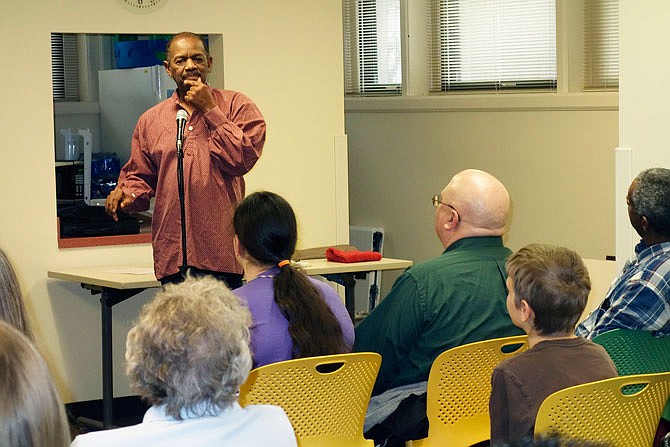George Washington Carver was a soft-spoken man with a high-pitched voice, but when he spoke, it was with intensity.
"The most striking thing about Carver were his eyes, like two burning coals," Emmy winning story teller Bobby Norfolk said at the Callaway County Library. "He talked with a wonderfully soft, musical voice."
Norfolk came back to Fulton on Monday to present a program about the man who wouldn't settle for anything less than an education. He also came in January to perform and educate people about Scott Joplin.
Local people were quick to educate Norfolk, too. A school in Fulton is named after George Washington Carver, and after that old school on Westminster Avenue is re-purposed as a community center, Norfolk is invited back to help dedicate it.
As a child, Norfolk overcame a stuttering obstacle and in 1975, became a stand-up comedian and actor. George Washington Carver overcame poverty and discrimination to become internationally known as an intelligent, learned man.
Carver was born into slavery in the early 1860s in Diamond, a small city in Newton County in Missouri's southwest corner. His master was Moses Carver, a German immigrant who had purchased his parents, Mary and Giles, in 1855 for $700.
When George was a week old, night raiders from Arkansas kidnapped him, his sister and his mother. Carver hired a man to find them, but only George was recovered and with his wife, Susan, Carver raised George and his brother James. They encouraged George to study, and "Aunt Susan" taught him the basics of reading and writing - along with cooking, cleaning and sewing.
While James grew big and strong, George did not.
"His muscles didn't grow, but his brain did," Norfolk said.
George spent time communing with nature and asking questions, setting him up for a natural career as a botanist who later developed techniques crop rotation and alternative crops.
"He wondered things like, why does a spider have eight legs when bugs and insects have six?" Norfolk said. "He had a Webster Spelling Book. He read through it 1,500 times and said, 'That's not enough knowledge.'"
Carver traveled to the closest school for black children, about 10 miles away from home, and found a kind, supportive family to stay with.
"He went to the colored school until he was smarter than the teacher," Norfolk said.
At age 13, Carver went to a new school in Kansas, but after seeing a black man murdered there, he left. He went to a variety of schools and then earned a diploma from Minneapolis High School in Kansas. He farmed a bit, studied art and piano at Simpson College in Iowa, then studied botany at Iowa State Agricultural College, the first black student there. He earned a master's degree there and then became that college's first black faculty member.
In 1896, Booker T. Washington of the Tuskegee Institute invited Carver to head its agriculture department. He taught there for 47 years, educating generations of black students how to farm for self sufficiency.
Carver published articles in peanut industry journals and wrote a syndicated newspaper column, "Professor Carver's Advice."
"He created 300 products with peanuts, but he did not invent peanut butter," Norfolk said. "Whole Foods Market, they own a debt of gratitude to George Washington Carver for organic farming."
He met with U.S. presidents, became a friend of automobile pioneer Henry Ford, and created a legacy, including the George Washington Carver Foundation at Tuskegee in 1938. He never married.
"He said his students were his family," Norfolk added.
In 1937, Carver visited Fulton to dedicate the school named for him, and local lore says he took "hedge apples" back to Tuskegee to study.
Carver died Jan. 5, 1943, at the age of 78. His brother, James, passed away in his 20s, Norfolk said.
On July 14, 1943, President Franklin D. Roosevelt dedicated $30,000 for the George Washington Carver National Monument near Diamond. This was the first national monument dedicated to an African American and the first to honor someone other than a president. The national monument opened in July 1953.
Throughout his life, Carver always found a fascination with nature, and was sometimes called "The Plant Doctor."
"He just had a childlike awe of nature," Norfolk said.

